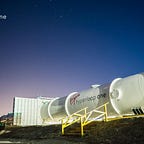Building Big Projects Requires Big Thinking
Hyperloop One’s transportation policy counsel Dan Katz on America’s great opportunity.
It’s Infrastructure Week, and to celebrate we’re running a series of conversations inspired by this advocacy effort to focus the nation’s attention on the investments we need to improve America’s infrastructure across the board. Deploying new technologies will help meet some of our challenges, so will streamlining the policies to make America more productive, competitive, and safe. It’s #TimeToBuild.
Our first conversation is a local stop, with Hyperloop One’s new Transportation Policy Counsel, Dan Katz. Few people know the ins and outs of the federal role in America’s transport infrastructure better than Dan. He joined Hyperloop One in February after 22 years in government, most recently as chief of staff to former Secretary of Transportation Anthony Foxx. Besides being the right-hand man who got things done in an agency of 60,000, Dan helped write the federal government’s policy on self-driving cars and the rules for connected-vehicle communication. Now he’s translating Hyperloop One’s technology, vision, and business models to policymakers everywhere.
Welcome to the private sector, Dan. Tell us the top three things you learned about how transportation policy works in Washington?
Great to be here. First I’d say that despite all of the partisan noise coming out of D.C. in general, the reality is that there is a lot of cooperation across the aisle on transportation in Washington. Secretary Foxx used to say that “there are no Democratic or Republican roads — there are just roads.” Transportation is the common denominator that brings all Americans together — and everyone recognizes that we need to improve our systems.
Secondly, what you realize is that, while D.C. makes policy and some funding decisions, the local level chooses the projects in America. The Federal government doesn’t originate ideas; in our system, they have to come from the state or local level. Of course, once there is an idea, Washington certainly has the power to kill it or boost it but, fundamentally, building big projects in the U.S. requires big thinking at the local level. That’s why the Hyperloop One Global Challenge is so exciting because the proposals are coming from the very people who make ambitious projects happen in this country.
And finally, I learned that there are great, devoted people working on transportation in the nation’s capital and at the state and local levels. On Capitol Hill, at USDOT, in the states and cities, and in the trade associations — across the board — these are people who want to build things and improve lives. It’s a great group to work with.
What policy decisions do you think will define the next era of transportation?
It’s a critical time right now for transportation. Our infrastructure, in general, is in bad shape. Our passenger rail system is behind almost every other developed country. Amtrak does a great job with the tools it has, but it is a very limited tool set. And our population is growing, so unless we change our ways, congestion is only going to get much worse.
So this is our pivot point. Right now. Clearly, everyone in Washington says they want to do something. To be effective, we need to move away from the conventional thinking that is no longer working. Europe and Asia are far ahead of us in high-speed rail deployment, but that is not a reason to panic. It’s an opportunity to leap beyond them and do much better.
That’s why Hyperloop is key. We are simply not going to advance our transportation system based on heavy rail technology from the 1800s. The smartphone revolutionized communication because American innovators decided to start over and build something from scratch using cutting-edge technology. That is what Hyperloop One is doing.
What do you see as the right approach to funding and regulating something totally new like the Hyperloop?
You can’t use old tools with new technology. A wrench won’t do anything but destroy a circuit board. The good news is that there are smart people in Congress and at DOT who understand this and are working in good faith to solve this problem.
What does the U.S. in 2030 look like if we only invest in the same technologies we’ve had for more than a century?
It will look like today, but much, much worse. And it’s not just a matter of convenience — it will cripple our economy. Freight movement will be strained to the breaking point. If we don’t invent new ways to move things and people on the ground, our country and economic system will come to a halt.
The beauty of Hyperloop One’s system is that our pods can move freight or passengers in a “packetized” way. Our control systems are designed to ensure that everything on the main line of the Hyperloop is running at an optimal speed and calibrate pod entry to the Hyperloop to prevent congestion and maximize efficiency. ]
As we see with automated cars, there is a recognition that we can make huge improvements in safety and reduce congestion by eliminating human error. Whether a shipping container or a passenger pod, in the Hyperloop One system, the human role will be limited to choosing the destination. That is where transportation needs to go if we are realistically going to leap forward and solve the congestion problems we face.
